Introduction
Picture this: a bustling cityscape with towering buildings, busy streets, and a constant hum of activity. As the sun beats down on the concrete jungle, the heat intensifies, creating an invisible barrier that seems to trap warmth within the city limits. This phenomenon, known as the urban heat island effect, has become a pressing concern in our modern world. It’s as if a dome, constructed by a culmination of carbon emissions, confined spaces, and limited ventilation, encapsulates the city, preventing the heat from escaping. The consequences are far-reaching, impacting energy consumption, public health, and the environment. In this blog, we delve into the intricacies of the urban heat island effect, exploring its causes, its impacts, and the innovative strategies being employed to combat it.
What is the Urban Heat Island Effect?
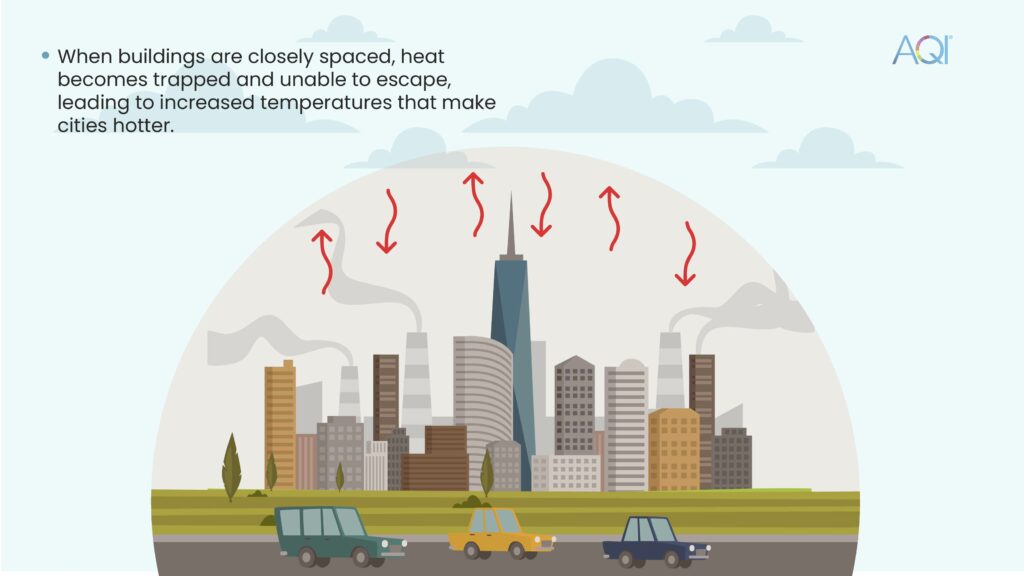
Have you ever wondered why summers in the city feel stiflingly hot, while nearby suburbs enjoy slightly cooler temperatures? The answer lies in a phenomenon called the urban heat island effect. Simply put, cities tend to be significantly hotter than their surrounding suburban areas.
But why does this happen?
The intricate web of factors contributing to this phenomenon can be explained by the unique characteristics of urban environments. From the abundance of concrete and asphalt to the compact arrangement of buildings, cities inadvertently create a heat-trapping effect that keeps temperatures elevated.
Why some cities are considered heat islands?
According to the EPA, heat islands are cities that have higher temperatures than the surrounding rural or suburban areas.
What creates heat islands?
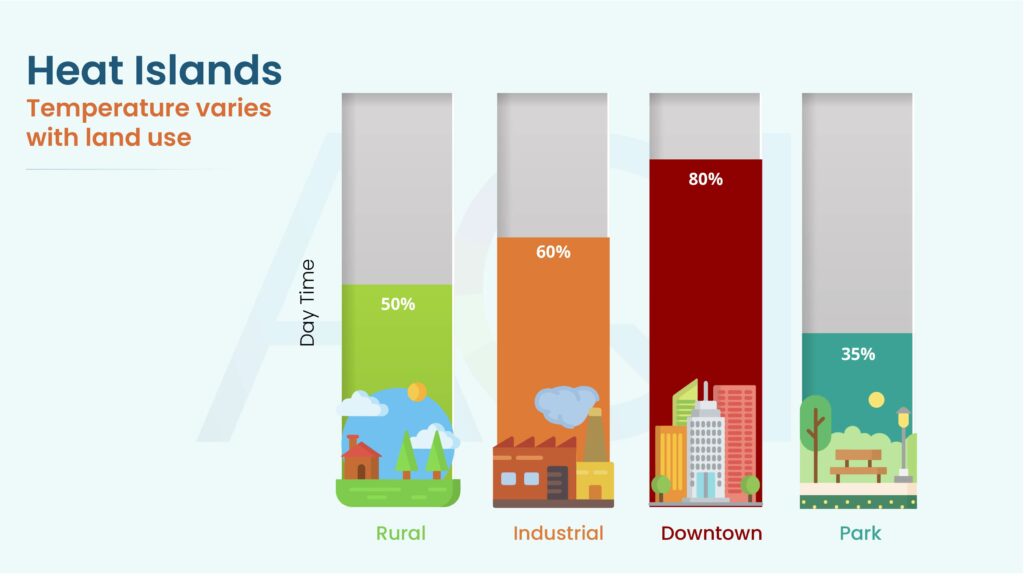
Urban areas often have more buildings, roads, and parking lots but less vegetation, trees, and water bodies. These green elements help cool the air by providing shade and moisture. Additionally, vehicles, air conditioning units, and industrial facilities in cities emit heat, further raising the surrounding temperatures.
Causes of Urban Heat Island Effect
1. Urbanization: With the construction of houses, roads, and infrastructure, natural vegetation, and soil are replaced with heat-absorbing materials such as concrete and asphalt.
2. Concrete Surfaces: Extensive areas of solid concrete surfaces, such as roads, parking lots, and sidewalks, prevent water from being absorbed into the ground, reducing evaporative cooling and increasing surface temperatures.
3. Reduced Vegetation: When opposed to rural areas, urban areas may have fewer trees and green spaces. The loss of vegetation diminishes the cooling effects of evapotranspiration, which occurs when plants release moisture into the air through photosynthesis.
4. Cities laid out in grids- Cities like Washington DC, Chicago, and Phoenix have a grid layout, tightly packed buildings that trap heat, while spaced-out buildings allow for better air circulation.
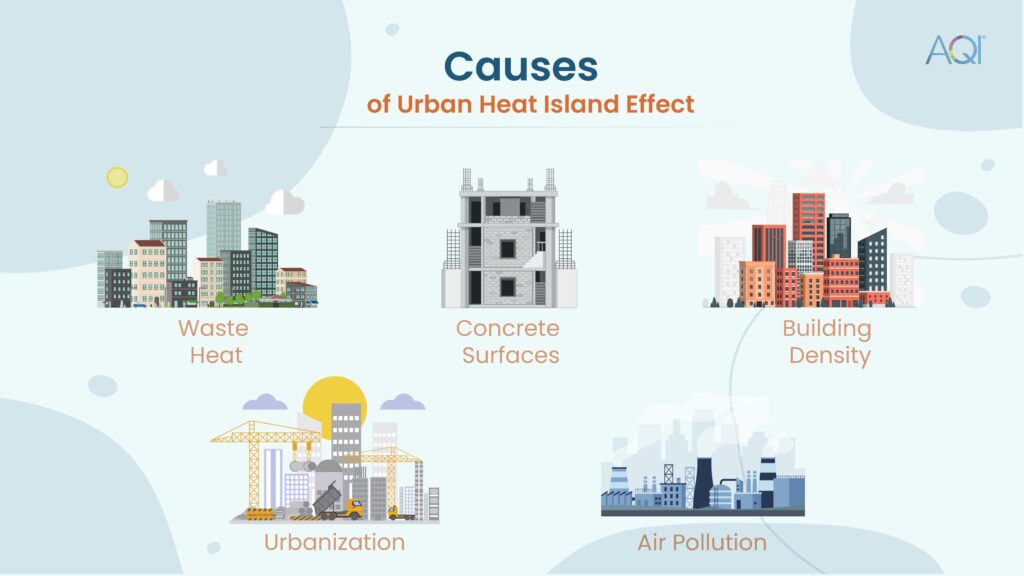
5. Waste Heat: Because of the high density of human activity in cities, energy consumption rises, resulting in the discharge of waste heat from buildings, automobiles, and industrial processes. The extra heat adds to higher temperatures in urban areas.
6. Building Density: Tall buildings and closely packed urban structures can restrict airflow, reducing natural ventilation and trapping heat between buildings.
7. Materials that absorb heat: Concrete and metal urban infrastructure have a high heat storage capacity, absorbing and radiating heat long after the sun has set, keeping urban areas relaxed at night.
8. Air Pollution: Because of industrial emissions, car exhaust, and other human activity, urban areas frequently have higher levels of air pollution. Air pollution can trap heat, escalating the urban heat island effect.
Impacts
1. Increased Energy Demand: The heat island effect causes higher temperatures in urban areas, increasing demand for air conditioning and cooling, resulting in increased energy consumption and higher electricity costs for residents and businesses.
2. Reduced Air Quality: High levels of air pollution are frequently associated with urban heat islands. The combination of heat and pollutants can cause smog and other dangerous pollutants to build, aggravating respiratory symptoms and jeopardizing overall air quality.
3. Human Health Risks: Excessive heat in urban environments poses health risks. Heat-related illnesses, heat strokes, and dehydration become more prevalent during heat waves.
4. Urban Heat-Related Mortality: Heatwaves associated with urban heat islands can result in an increased number of heat-related deaths. The intense and prolonged heat can strain the human body’s ability to regulate temperature, leading to heat exhaustion and heatstroke.
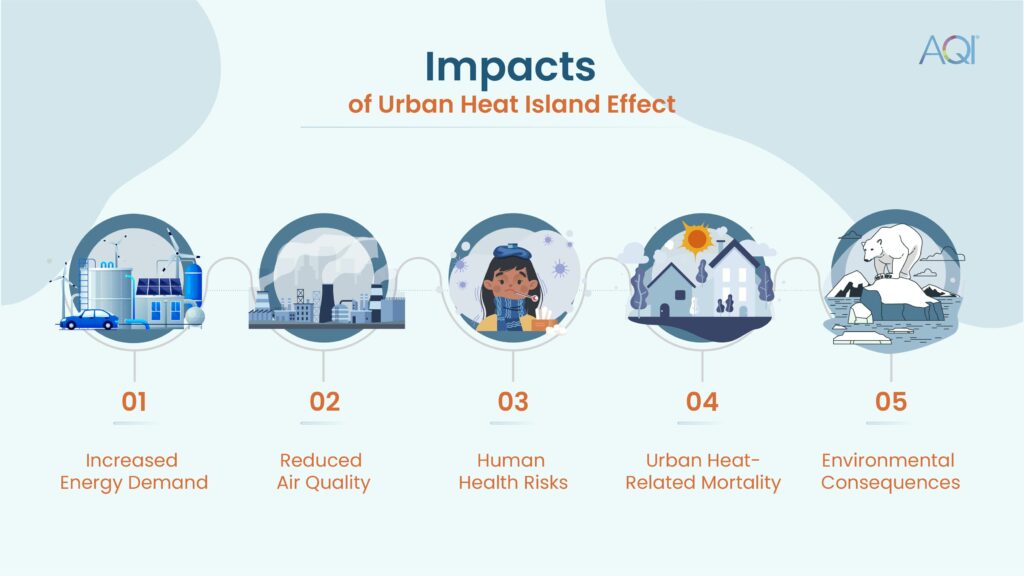
5. Environmental Consequences: The altered microclimate within urban areas affects the local ecosystem. It can disrupt plant and animal habitats, reduce biodiversity, and impact the natural balance of ecosystems. Additionally, higher temperatures contribute to increased water evaporation and can strain water resources in urban areas.
Examples
- In 2020, Houston collaborated with multiple agencies for a heat mapping project, revealing a significant 17+ degree gap between the hottest and coolest spots in Houston and Harris County.
- A study conducted in New York compared temperatures in the South Bronx to Central Park, revealing a striking 20-degree difference during the day and an even greater 22-degree difference at night.
- Researchers observed a temperature of 103 degrees on Richmond Avenue near Chimney Rock, while Channel View typically experienced an average of 86 degrees on the same day.
Mitigation Strategies
There are four ways to reduce the heat island effect:
1. Plant more trees and create urban gardens: Adding more trees and green spaces helps cool the area by releasing moisture into the air. These natural elements counteract the heat absorbed by buildings, making the surroundings cooler.
2. Retrofit buildings and create living rooftops: Transforming building rooftops into green spaces or painting them white helps reflect sunlight instead of storing it as heat. This simple change can significantly reduce temperatures in urban areas.
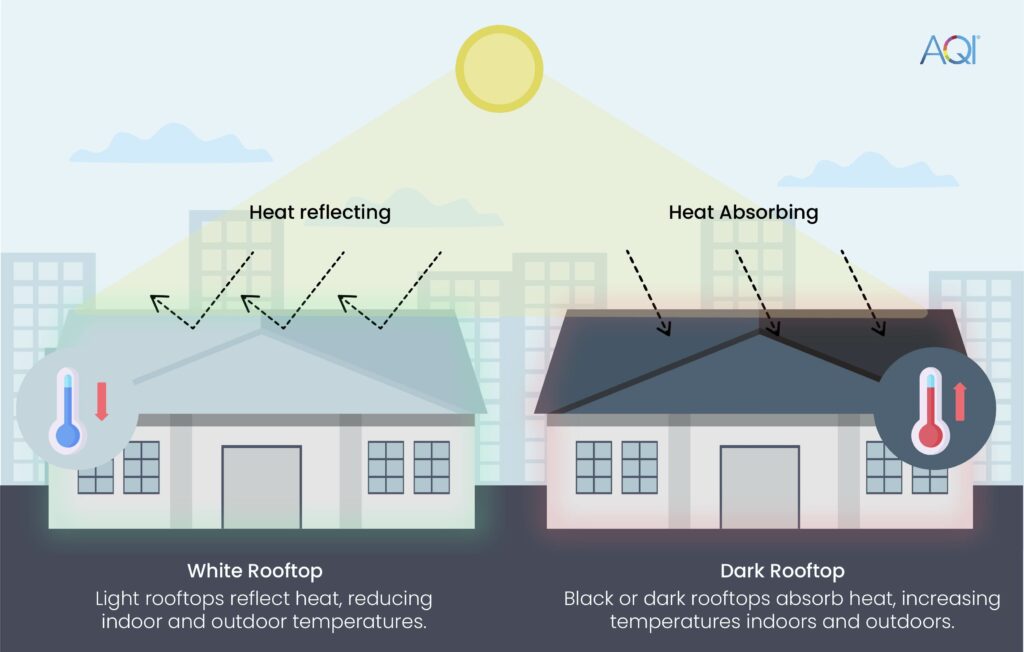
3. Support communities during heat waves: It’s important to alert and assist communities during extreme heat events. Providing water and checking on people’s well-being are crucial steps. Additionally, leaving water out for birds and animals helps them stay hydrated in hot weather.
4. Limit air conditioning usage: Using air conditioning only when necessary helps combat the heat island effect in the long run. AC units consume a lot of electricity, which often comes from fossil fuels, leading to increased carbon dioxide emissions and further warming the planet.
By implementing these strategies, we can make cities cooler, more comfortable, and environmentally friendly.
Conclusion
The intense heat trapped within urban environments due to factors such as urbanization, lack of vegetation, and heat-retaining materials has wide-ranging impacts on energy consumption, human health, air quality, and the environment.
This is not just about comfort. Today, heat waves kill more people than any other extreme weather event. More than tornadoes, hurricanes, and even floods. City populations keep growing, and those cities are only getting hotter.

Planting more trees and creating urban gardens, retrofitting buildings with green rooftops, and implementing strategies to support communities during heat waves are effective ways to combat rising temperatures. Additionally, adopting sustainable practices like limiting unnecessary air conditioning usage can contribute to long-term solutions.